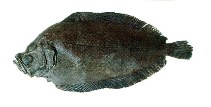Mancopsetta maculata (Günther, 1880)
Antarctic armless flounder
Beobachtung melden im Fish Watcher
| Native range | All suitable habitat | Point map | Year 2050 |

|
| This map was computer-generated and has not yet been reviewed. |
| Mancopsetta maculata AquaMaps Data sources: GBIF OBIS |
Hochladen Photos und videos
Pictures | Google BildMancopsetta maculata
Picture by INIDEP
Pictures | Google BildMancopsetta maculata
Picture by INIDEP
Common names from other countries
Klassifizierung / Names Namen | Synonyme | Catalog of Fishes(Gattung, Arten) | ITIS | CoL | WoRMS | Cloffa
> Pleuronectiformes (Flatfishes) > Achiropsettidae (Southern flounders)
Etymology: Mancopsetta: Latin, mancus = incomplete + Greek, psetta = grouper (Ref. 45335).
More on author: Günther.
Etymology: Mancopsetta: Latin, mancus = incomplete + Greek, psetta = grouper (Ref. 45335).
More on author: Günther.
Environment: milieu / climate zone / depth range / distribution range Ökologie
seewasser demersal; tiefenbereich 100 - 1115 m (Ref. 5192). Temperate; 37°S - 67°S
Verbreitung Länder | FAO Gebiete | Ecosystems | Vorkommen | Point map | Einführungen | Faunafri
Southern Ocean, South Atlantic, and South Indian Ocean. Argentine shelf/slope from 37°S to the Falklands and Burdwood Bank. Also Kotlyar; Crozet Islands and Prince Edward Island (Ref. 5000). Recorded from Chile (Ref. 27363).
Size / Gewicht / Alter
Kurzbeschreibung Bestimmungsschlüssel | Morphologie | Morphometrie
Rückenflossenstacheln (insgesamt) : 0; Rückenflossenweichstrahlen (insgesamt) : 112 - 129; Afterflossenstacheln: 0; Afterflossenweichstrahlen: 91 - 104. Pelvic fin on ocular side (with 7 soft rays) extremely larger than on blind side (with 5 soft rays). Caudal fin rounded (Ref. 27363).
Inhabit the lower continental shelves with surface-dwelling larvae and juveniles (Ref. 11892).
Life cycle and mating behavior Geschlechtsreife | Fortpflanzung | Ablaichen | Eier | Fecundity | Larven
Hauptreferenz
Upload your references | Referenzen | Koordinator | Partner
Heemstra, P.C., 1990. Achiropsettidae. p. 408-413. In O. Gon and P.C. Heemstra (eds.) Fishes of the Southern Ocean. J.L.B. Smith Institute of Ichthyology, Grahamstown, South Africa. (Ref. 5000)
IUCN Rote Liste Status (Ref. 130435: Version 2024-2)
nicht bedroht (LC) ; Date assessed: 16 December 2020
Bedrohung für Menschen
Harmless
Nutzung durch Menschen
Fischereien: kommerziell
FAO(Fischereien: production; publication : search) | FishSource | Sea Around Us
Mehr Information
Population dynamics
Growth parameters
Max. ages / sizes
Length-weight rel.
Length-length rel.
Längenhäufigkeiten
Mass conversion
Rekrutierung
Dichte
Growth parameters
Max. ages / sizes
Length-weight rel.
Length-length rel.
Längenhäufigkeiten
Mass conversion
Rekrutierung
Dichte
Life cycle
Fortpflanzung
Geschlechtsreife
Fecundity
Ablaichen
Spawning aggregations
Eier
Eientwicklung
Larven
Larven Pop.Dyn.
Fortpflanzung
Geschlechtsreife
Fecundity
Ablaichen
Spawning aggregations
Eier
Eientwicklung
Larven
Larven Pop.Dyn.
Anatomy
Kiemenoberfläche
Brain
Otolith
Kiemenoberfläche
Brain
Otolith
Physiology
Body composition
Nutrients
Oxygen consumption
Swimming type
Swimming speed
Visual pigments
Fish sound
Diseases & Parasites
Toxicity (LC50s)
Body composition
Nutrients
Oxygen consumption
Swimming type
Swimming speed
Visual pigments
Fish sound
Diseases & Parasites
Toxicity (LC50s)
Genetics
Genetik
Heterozygosity
Vererbbarkeit
Genetik
Heterozygosity
Vererbbarkeit
Human related
Aquaculture systems
Aquakultur Profile
Zuchtlinien
Ciguatera cases
Stamps, coins, misc.
Aquaculture systems
Aquakultur Profile
Zuchtlinien
Ciguatera cases
Stamps, coins, misc.
Tools
E-book | Feldführer | Längenhäufigkeits Tool | Lebensdaten Tool | Punkt Karte | Classification Tree
| Catch-MSY |
Zusatzinformationen
Download XML
Zusammenfassung | Point data | Namen | Photos
Internet Quellen
Aquatic Commons | BHL | Cloffa | BOLDSystems | Websites from users | FishWatcher Einträge suchen | CISTI | Catalog of Fishes(Gattung, Arten) | DiscoverLife | ECOTOX | Faunafri | Fishtrace | GenBank(Genom, nucleotide) | GloBI | GOBASE | | Google Books | Google Scholar | Google | IGFA World Record | MitoFish | Nationale Datenbanken | Otolith Atlas of Taiwan Fishes | PubMed | Reef Life Survey | Scirus | SeaLifeBase | Tree of Life | Wikipedia(Gehe zu, Suchen) | World Records Freshwater Fishing | Zoological Record
Estimates based on models
Preferred temperature (Ref. 115969): 1.4 - 5.8, mean 3.3 (based on 139 cells).
Phylogenetic diversity index (Ref. 82804): PD50 = 1.0625 [Uniqueness, from 0.5 = low to 2.0 = high].
Bayesian length-weight: a=0.01072 (0.00516 - 0.02226), b=3.01 (2.82 - 3.20), in cm Total Length, based on LWR estimates for this species & (Sub)family-body (Ref. 93245).
Trophic level (Ref. 69278): 3.7 ±0.54 se; based on food items.
Widerstandsfähigkeit (Ref. 120179): mittel, Verdopplung der Population dauert 1,4 - 4,4 Jahre. (tm=2-3).
Fishing Vulnerability (Ref. 59153): Moderate vulnerability (44 of 100).
Climate Vulnerability (Ref. 125649): High to very high vulnerability (74 of 100).




